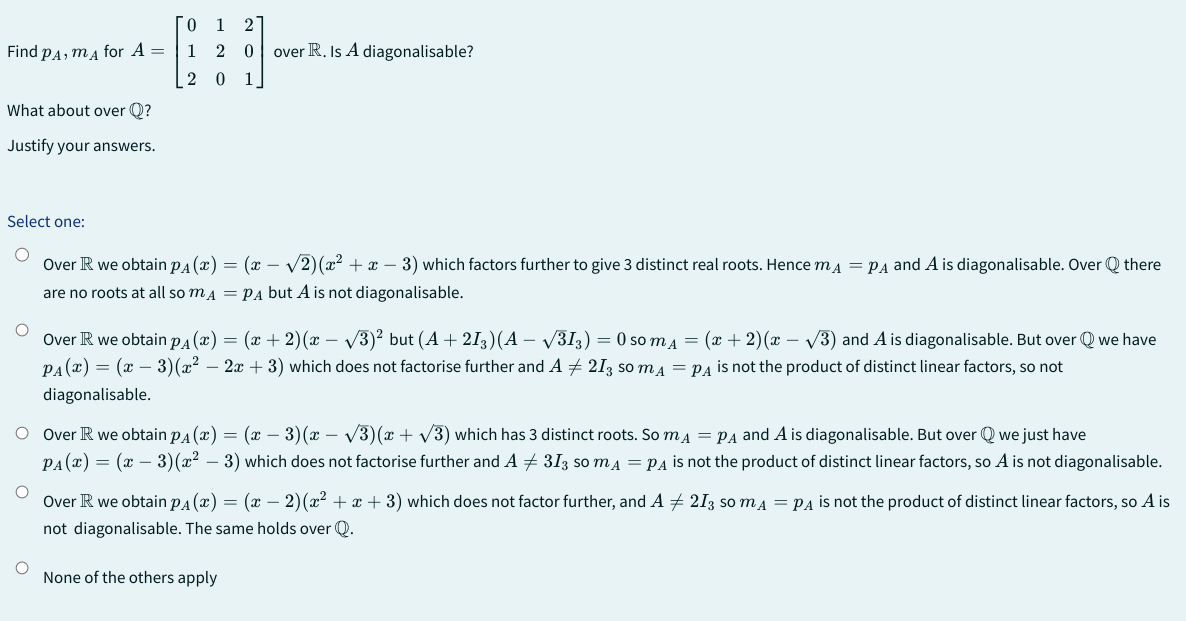Find PA, MA for A = What about over Q? Justify your answers. Select one: 0 1 2 1 20 201 O over R. Is A diagonalisable? Over R we obtain P(x) = (x - √2)(x² + x - 3) which factors further to give 3 distinct real roots. Hence mA = PA and A is diagonalisable. Over Q there are no roots at all so mA = PA but A is not diagonalisable. O Over R we obtain P(x) = (x + 2)(x − √√3)² but (A +213) (A - √313) = 0 so m₁ = (x + 2)(x - √√3) and A is diagonalisable. But over Q we have PA(x) = (x − 3)(x² - 2x + 3) which does not factorise further and A 213 so mA = PA is not the product of distinct linear factors, so not diagonalisable. O Over R we obtain p₁(x) = (x − 3)(x − √3)(x + √3) which has 3 distinct roots. So mA = PA and A is diagonalisable. But over Q we just have PA(x) = (x − 3)(x² - 3) which does not factorise further and A 313 so mA = PA is not the product of distinct linear factors, so A is not diagonalisable. Over R we obtain P₁(x) = (x − 2)(x² + x + 3) which does not factor further, and A ‡ 213 so mд = PÅ is not the product of distinct linear factors, so A is not diagonalisable. The same holds over Q. None of the others apply
Find PA, MA for A = What about over Q? Justify your answers. Select one: 0 1 2 1 20 201 O over R. Is A diagonalisable? Over R we obtain P(x) = (x - √2)(x² + x - 3) which factors further to give 3 distinct real roots. Hence mA = PA and A is diagonalisable. Over Q there are no roots at all so mA = PA but A is not diagonalisable. O Over R we obtain P(x) = (x + 2)(x − √√3)² but (A +213) (A - √313) = 0 so m₁ = (x + 2)(x - √√3) and A is diagonalisable. But over Q we have PA(x) = (x − 3)(x² - 2x + 3) which does not factorise further and A 213 so mA = PA is not the product of distinct linear factors, so not diagonalisable. O Over R we obtain p₁(x) = (x − 3)(x − √3)(x + √3) which has 3 distinct roots. So mA = PA and A is diagonalisable. But over Q we just have PA(x) = (x − 3)(x² - 3) which does not factorise further and A 313 so mA = PA is not the product of distinct linear factors, so A is not diagonalisable. Over R we obtain P₁(x) = (x − 2)(x² + x + 3) which does not factor further, and A ‡ 213 so mд = PÅ is not the product of distinct linear factors, so A is not diagonalisable. The same holds over Q. None of the others apply
Mathematics For Machine Technology
8th Edition
ISBN:9781337798310
Author:Peterson, John.
Publisher:Peterson, John.
Chapter55: Introduction To Circles
Section: Chapter Questions
Problem 20A: Solve the following exercises based on Principles 11-14, although an exercise may require the...
Related questions
Question

Transcribed Image Text:Find p₁, mд for A =
What about over Q?
Justify your answers.
Select one:
0 1 2
1 2 0
20 1
O
over R. Is A diagonalisable?
Over R we obtain P(x) = (x − √2)(x² + x - 3) which factors further to give 3 distinct real roots. Hence mA = PA and A is diagonalisable. Over Q there
are no roots at all so mд = PÅ but A is not diagonalisable.
O
Over R we obtain P(x) = (x + 2)(x − √3)² but (A +213)(A - √313) = 0 so m₁ = (x + 2)(x − √√3) and A is diagonalisable. But over Q we have
PA(x) = (x − 3)(x² - 2x + 3) which does not factorise further and A 213 so m₁ = PA is not the product of distinct linear factors, so not
diagonalisable.
O Over R we obtain p(x) = (x − 3)(x − √√3)(x + √√3) which has 3 distinct roots. So mд = PA and A is diagonalisable. But over Q we just have
PA(x) = (x − 3)(x² - 3) which does not factorise further and A 313 so m₁ = PA is not the product of distinct linear factors, so A is not diagonalisable.
Over R we obtain P₁(x) = (x − 2)(x²+x+3) which does not factor further, and A 213 so mA = PA is not the product of distinct linear factors, so A is
not diagonalisable. The same holds over Q.
O
None of the others apply
Expert Solution
This question has been solved!
Explore an expertly crafted, step-by-step solution for a thorough understanding of key concepts.
Step by step
Solved in 4 steps with 3 images

Recommended textbooks for you

Mathematics For Machine Technology
Advanced Math
ISBN:
9781337798310
Author:
Peterson, John.
Publisher:
Cengage Learning,

Algebra & Trigonometry with Analytic Geometry
Algebra
ISBN:
9781133382119
Author:
Swokowski
Publisher:
Cengage

Mathematics For Machine Technology
Advanced Math
ISBN:
9781337798310
Author:
Peterson, John.
Publisher:
Cengage Learning,

Algebra & Trigonometry with Analytic Geometry
Algebra
ISBN:
9781133382119
Author:
Swokowski
Publisher:
Cengage